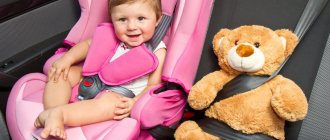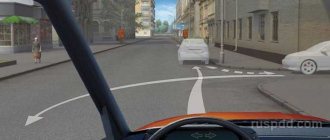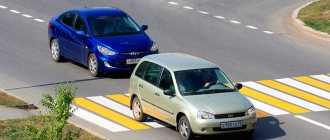- 1. At what age can you transport a child in the front seat without a seat?
- 2. Can I carry a child in the front seat - quick test
- 3. Is it possible to transport a child in the front seat of a Gazelle?
- 4. How will a traffic police inspector determine whether a child is 7 years old or not?
- 5. What is the fine for an unbelted child?
- 6. Can the inspector prohibit further movement after a fine?
Changes regarding the transportation of children in the front seat of a car were made to the traffic rules on July 12, 2021. The changes in this regard were significant. If previously a child under 12 years old could not be transported without a car seat, now this can be done, but with certain subtleties and conditions. From what age can you transport a child in the front seat in cars and trucks (including when it comes to a child in the front seat in a Gazelle), what are the nuances of transporting children without a car seat, wearing standard seat belts, we will look into article.
You will also be interested in:
- Fines for violations of the rules for transporting passengers in situations
- What changes to the traffic rules came into effect in the summer (July) 2021?
- Can frameless child car seats be used in a car? From what age?
Let's talk about everything in order!
Child in a car
Most often, parents transport their children in private cars. Please note that category B includes not only passenger cars, but also small trucks. For them, the transportation rules are different and they will be discussed below.
| Age | Conditions of transportation |
| from 0 to 11 years | Only using a child restraint |
| from 11 to 18 years old | Using standard seat belts |
What devices can be used to transport children
Rules for transporting children according to traffic rules in a car in 2021
Without special devices, transporting children in a car in the front seat is allowed from 12 years of age. The child's height must be at least 1.5 meters. For safety, it is necessary to use standard securing straps, adjusting them accordingly.
The table shows the official standards for children's car safety devices, in accordance with the law and the requirements of the State Traffic Safety Inspectorate.
Law enforcement officials can impose fines not only for the absence of a child seat, but also for improper installation of the accessory, or violation of the norms for accompanying children at night. The seat is not allowed to be installed upside down. This contributes to serious injury or death as a result of an accident or emergency stop.
After 12 years, children can already be transported without using a car seat, but only if the child is taller than 1.5 meters. If his height does not exceed the specified mark, then it is worth using holding devices. Also, from the age of 12, a child can ride in the front seat without special restraints , fastened only with adult seat belts.
| Violation | Article of the Code of Administrative Offenses of the Russian Federation | Punishment |
| Absence of identification signs “Transportation of children” or “Speed limit” on a bus transporting children | Part 1 Art. 12.5 Code of Administrative Offenses of the Russian Federation | warning or 500 rub. fine |
| “Children in the car” sticker obstructs the driver’s view | Part 1 Art. 12.5 Code of Administrative Offenses of the Russian Federation | warning or 500 rub. fine |
| Violation of the rules for transporting children (carriage of a child under 12 years old in the front seat of a car without a car seat, in the back seat of a motorcycle, etc.) | Part 3 Art. 12.23 Code of Administrative Offenses | Fine 3000 rubles. — for the driver; 25,000 rub. - for officials; 100,000 rub. - for legal entities. |
| Violation of the rules for the organized transportation of children from 23.00 to 6.00. | Part 5 Art. 12.23 Code of Administrative Offenses of the Russian Federation | for the driver - 5000 rubles. fine or deprivation of driving license for 4 - 6 months; for officials - 50,000 rubles; for legal entities - 200,000 rubles. |
| Violation of the requirements for the organized transportation of children to buses, drivers or documents | Part 4 Art. 12.23 Code of Administrative Offenses of the Russian Federation | Fine 3000 rubles. — for the driver; 25,000 rub. - for officials; 100,000 rub. - for legal entities. |
| Violation of other requirements for organized transportation of children | part 6 art. 12.23 Code of Administrative Offenses of the Russian Federation | Fine 25,000 rubles. - for officials; 100,000 rub. - for legal entities. |
Child in the cab of a truck
This section deals with trucks of all types. Starting with multi-ton tractors and ending with light trucks based on cars.
What is of fundamental importance is not the appearance and size of the car, but the information specified in the “Vehicle Type” field of the registration certificate. If the value “truck” is entered in this field, then the following rules should be used:
| Age | Conditions of transportation |
| from 0 to 7 years | Only using a child restraint |
| from 7 to 11 years | Using a child restraint or seat belt |
| from 11 to 18 years old | Using standard seat belts |
Rules for transporting children in a car in 2021: basic provisions
The fine for not having a child seat varies depending on who committed the offense:
| Responsible person | Amount of fine in rubles |
| Driver (Parents, relatives) | 3 000 |
| Officials – educators, teachers, taxi drivers | 25 000 |
| Legal entities – school, taxi company | 100 000 |
It is possible to pay the fine with a 50% discount within 20 days from the date of delivery of the decision to the citizen.
Most often, difficulties with the law on child seats arise in large families. One car can comfortably accommodate two, rarely three, seats, but without them all four or even five children could fit in the back seat.
Another drawback is the imposition of fines on taxi drivers. Sometimes parents deliberately do not warn that there will be a child in the cabin, so as not to increase the cost of the trip. When an inspector stops a car, the blame falls on the taxi driver. In extreme cases, the fine for parents will be 3,000 rubles, and for the driver – 25,000.
Types of car seats for children on the Russian market:
| Child's age | Restraint type | Weight in kg. | Group (class) car seats |
| from birth to 1 year | Carrying or “cradle”. They are installed in the car in one of two positions: horizontal, in which the child can sleep in the car, vertical, in which the baby is held using a special belt. | to 10 | 0 |
| up to 1.5 years. Can be used for children from the first day of life. | Armchair. The child in it is in a “reclining” state. The device can be positioned either with your back or facing the direction of travel. | up to 13 | 0+ |
| from 1 year to 4 years | Armchair. Installation can only be done in the direction of travel of the vehicle. The child is secured using durable, five-point harnesses. | 9-18 | 1 |
| from 3 to 7 years | Armchair. Standard seat belt. The chair has an adjustable backrest that can be adjusted to the height of the child. | 15-25 | 2 |
| from 7 to 12 years | Seat without backrest. The child is held in place by an additional seat belt. | up to 36 | 3 |
Each type of seat is used only for children of a certain age. Some car seats, for example, categories 0 and 0+, are adjustable depending on the child’s height and weight, but from 1.5 years old it is necessary to purchase a larger seat.
When purchasing a child seat for your car, there are a few things to consider:
- Type of belt fastening. There are two types of fastenings: standard and improved - ISOFIX. Both options are suitable for passing a traffic police check, but the ISOFIX system is more reliable in the event of an accident.
- Seat belts on the seat. Small children must be secured in the bassinet. Special built-in belts are designed for this - three- or five-point. Fixing with a safety table is also possible. The best option is a five-point harness.
- Chair frame. The most durable and reliable is the aluminum frame, as opposed to plastic.
- You should choose those models that are equipped with a durable, large headrest and sides.
- Preference should be given to covers made of cotton fabric, as they are better suited to the baby's skin and do not irritate it.
If a child is traveling in a car with his parents, in 2021 the classic transportation rules apply. The minor must be in a car seat that is suitable for his height and age. Transporting children under 12 years of age in the front seat of a car is not prohibited if special restraints are used. Parents must select the appropriate device themselves.
Minor passengers are allowed to be transported in cars and truck cabins, subject to certain rules. It is prohibited to transport children under 12 years of age on the back seat of a scooter or motorcycle. Now they are allowed to be transported in passenger cars if the seat is equipped with a special seat or cradle. The booster and triangular configuration adapter are not suitable for this.
Recommendations for the correct transportation of infants in vehicles are prescribed in the Russian Federation Traffic Regulations, in paragraph 22.9. The latest version states that it is not allowed to transport newborns without restraints. There are no detailed explanations, but this implies the use of a cradle, LDC, stroller, car seat, taking into account the age and weight of the passenger.
If the question arises whether it is possible to transport a small child in your arms, it is worth reading clause 22.9 of the Russian Traffic Regulations, as amended. The rules here are the same as for children under one year of age, provided that there is a device that matches the weight and age of the baby. Passengers under 7 years of age and older are allowed to travel if standard seat belts or a system with the Isofix mark -1 are provided.
The law on transporting children in a car states: it is permissible to transport a child in the front seat if there is a standard restraint element. If a small passenger is in the back seat of a car or truck cab, he must be fastened with seat belts or be protected by a securing device.
It is not necessary to buy a separate seat - you can make it yourself for free, in compliance with the requirements of traffic rules for transporting children, depending on the year of birth. The created accessory will protect the little passenger if the design meets all the necessary requirements.
If you have doubts about a homemade device, it is better to buy a factory analogue. The child can be involved in choosing a child car seat. This helps to purchase the most comfortable model, taking into account anthropometric data. You should not buy an accessory “for growth”. The operation of such products does not give the desired effect. Among the main selection criteria are the types of fastenings and methods of fixation.
Child on the bus
This section deals with buses of all types, i.e. about vehicles with more than 8 passenger seats. The size of the vehicle, again, does not matter. The buses can be either small minivans or huge tourist buses.
| Age | Conditions of transportation |
| from 0 to 18 years | Using standard seat belts |
Let's look at an interesting example. Gazelle minibuses have become widespread in Russia. Moreover, they are available in various modifications.
The registration certificate may indicate the following vehicle type options:
- cargo van;
- bus (other buses).
Externally, Gazelles of different modifications are similar to each other, but the rules for transporting children in the front seat differ. On a bus, a child of any age can be fastened with a regular seat belt, but on a cargo van, a child restraint system is required for children under 7 years of age.
Is it possible to transport a child in the front seat of a Gazelle?
In the front seat of a Gazelle (canopy, van), where there is no back row of seats at all, sometimes it is also necessary to seat a child. Do I need a car seat for this or can I fasten it with a belt? After all, on the one hand, the Gazelle’s PTS indicates that this vehicle belongs to a truck, on the other hand, the car weighs less than 3.5 tons, and almost all traffic rules apply to the Gazelle as a passenger car!
The answer to this question is clear. Traffic regulations clearly do not distinguish between trucks and passenger cars in the context of their curb weight of up to 3.5 tons or more. There are requirements either for the weight of the car or for its type. In paragraph 22.9 of the traffic rules, trucks are specified, therefore the Gazelle in the context of this paragraph refers specifically to trucks.
This means that a child can be transported in the Gazelle in the front seat with a seat belt fastened if he is over 7 years old. Moreover, regardless of whether the Gazelle has a rear row of seats (“Farmer” or passenger version) or not.
Airbag deactivation
Most new modern cars are equipped with a passenger airbag located opposite the front passenger seat. At the same time, it is technically possible to turn off this pillow when transporting a child.
In this regard, drivers have a question: is it always necessary to turn off the airbag when installing a child seat in the front seat? Or only when the seat is installed rear-facing?
Getting an answer to this question is quite easy. You should refer to your vehicle's owner's manual and look for the section on transporting children.
In the process of writing this article, I turned to the operating manual for my car and found the following information there:
When installing a child seat on the front passenger seat in which the child sits backwards, the front passenger's front airbag must be deactivated.
Moreover, the information is duplicated on different pages of the book at least 3 times. However, nothing is said about the fact that the airbag needs to be turned off when installing the seat in the direction of travel.
Those. In my car, the airbag only needs to be turned off when the child is sitting in the seat backwards.
I recommend studying your car's manual and finding similar information there. Please note that information may vary! In some cars, the airbag must be turned off when the seat is installed in a rear-facing position, as well as when installed in a forward-facing position.
Changes to the rules for transporting children in a car in questions and answers
The first fine for not having a car seat for a child, 500 rubles, was introduced in 2007. Since that time, it has increased several times, and by 2021 it amounted to 3,000 rubles. up to 100,000 rubles, depending on a number of accompanying circumstances.
Standards for the safe passage of children in vehicles were prescribed in the traffic rules back in 1993. According to them, the possibility of transporting a child in the back or front seat of a car was regulated. They established criteria under which standard seat belts could be used, or whether additional means were required.
Rules for the passage of children in motor vehicles place full responsibility for their observance on adults. According to them, there are separate standards for transporting a child in the rear or front car seat.
Children can ride in the front seat of a car if the following conditions are met:
- if a child is over twelve years old, weighs 36 kg or more, and is at least 150 cm tall, he can ride in the front seat of a car, fastened with regular car seat belts;
- If a child is under twelve years old, weighs less than 36 kg, and is not 150 cm tall, he can ride in the front using assistive safety devices (car seats and their equivalents).
Safe passage of children in the back seat of a car requires the following conditions:
- if the child is twelve years old, his weight and height have reached the required parameters (150 cm, 36 kg), he can ride in the back seat of a car, fastened with regular seat belts;
- If a child is under twelve years old, weighs less than 36 kg, and is not 150 cm tall, he can ride in the back seat of a car using additional safety equipment (child car seat and similar).
The use of auxiliary safety devices that are inappropriate for the weight, age and height of the child, according to the traffic rules, is perceived as a lack of necessary safety devices.
Transporting a child without a car seat, or with a device that is inappropriate for his age, height and weight, is punishable by penalties. The size of the fine depends on a number of factors and can range from 3 thousand rubles. up to 100 thousand rubles.
How much is the fine for a child seat in 2021?
There are several degrees of responsibility for failure to comply with the standards for the safe transportation of children in vehicles.
| The person who committed the violation | Penalties (RUB) |
| Individual – parents, relatives, acquaintances, etc. | 3 000 |
| Official - taxi driver, teacher, educator, etc. | 25 000 |
| Organization – educational institution, organization performing passenger transportation, etc. | 100 000 |
Individuals belonging to different groups may be subject to separate liability for violating the standards for the safe transportation of a child.
In the case of a trip in a taxi that is not suitable for transporting a child, the fine for driving without a child seat in the car will be paid by both the driver (25,000 rubles) and the passenger accompanying the child - a parent, relative (3,000 rubles) or a teacher, educator ( 25,000 rub.).
If there are clear signs of violation of the standards for the safe transportation of children, the organization providing transportation may be additionally held liable.
If a child is in a car seat while a vehicle is moving without securing it, it is equivalent to the absence of a car seat. The penalty for an unbelted child is the same as the penalty for a child without a child seat . (from 3,000 rubles to 100,000 rubles).
In addition, penalties are possible in the following cases:
- a child in the arms of an adult while the car is moving (it does not matter whether the child and passenger are buckled up or not);
- the car seat is clearly not suitable for the child’s body type;
- there is more than one child in/on the car seat;
- the car seat is not secured.
Rules for organized transportation of a group of children by bus
- transportation of minors by non-route vehicles;
- transportation of groups of children of 8 people or more;
- transportation of children's groups without representatives (parents, guardians, adoptive parents).
- The vehicle must meet the technical requirements for design and purpose.
- It is mandatory to have a diagnostic card or technical certificate confirming the serviceability of the bus.
- To be able to determine the location of a vehicle at any time of the day, a GLONASS satellite navigator must be installed.
- Each bus must have a tachograph, which monitors the driver’s rest schedule and the speed of the bus.
Tips for choosing a restraint system
A child car seat is a seat used for transporting minors. It is used from the birth of the baby until he grows to 150 cm or weighs 36 kg. It protects children during extreme driving and forced stops. The risk of death in an accident is reduced by 75% if the car seat is selected correctly and installed according to the instructions.
As children grow older, they will need car seats from different weight groups. Manufacturers have begun to produce transforming models that can be adjusted to a child’s growing body. Car seats must comply with the standards of the Technical Regulations of the EAEU Customs Union. Their body is made of impact-resistant materials, and the cover is made of hypoallergenic fabric. They differ from each other in:
- age;
- method of fastening;
- manufacturing material.
Separation by age categories makes it easier for parents to choose a new car seat. The table shows groups of car seats by child’s age:
From birth to six months
For newborns and children who weigh little, a cradle that looks like a stroller's basket is suitable. The baby is inside the cradle, fastened with its internal belts, and the cradle itself is secured with a car seat belt.
Before the first year of life
Image source: https://www.detmir.ru/product/index/id/3142302/
Car seats from this group are also called baby carriers. Their body is made in the shape of a bowl, which is complemented by a 5-point belt. A handle is provided for transportation. They are placed rear-facing to relieve stress on poorly developed musculoskeletal tissue and also to protect infants from the head bobbing that can cause death when stopping abruptly.
From 1 year to 4 years
Image source: https://www.detmir.ru/product/index/id/2391161/
A group 1 car seat can be placed either facing the traffic or facing it. It should have a 5-point seat belt and an adjustable backrest tilt that moves it to a reclining position. The device is designed for one-year-old babies who can already sit. It can be used until the child’s weight reaches 15-18 kg, then he should transfer to a group 2 car seat.
From 3 to 7-12 years
Image source: https://www.detmir.ru/product/index/id/3142308/
Car seats of group 2, intended for transporting a child 3-7 years old, are less common than transformers. Products of groups 2 and 3 are combined into general models, which no longer have 5-point belts, but have guides for a standard belt. Children at this age can only be fastened with a standard car belt, passing it along the guides.
Car seats 3 groups
Image source: https://www.detmir.ru/product/index/id/1827731/
Devices designed for passengers taller than 1.3-1.35 m are called boosters. They are made without side protection, and are only a hard seat, equipped with armrests and guides for the standard car belt. Booster seats are not as safe as regular car seats with a backrest.
TRANSPORT SERVICE 8-961-306-306-1
The cost of transportation by gazelle in Rostov-on-Don starts from 350 rubles per hour, minimum 2 hours. The cost depends on the modification of the vehicle used to transport the cargo, as well as on the distance that needs to be covered.
We recommend reading: Sample sheet of amendments to the charter on changing the legal address
Gazelle intercity , price per kilometer:
How much does it cost to transport cargo by gazelle intercity? The cost of freight transportation up to 2 tons intercity is 11-13 rubles/km, round trip. The cost per km depends on the distance of the trip; when making a long trip, the cost per kilometer will be 11 rubles.
Gazelle for intercity transportation
The Gazelle is rightly considered the optimal transport in terms of efficiency . This also applies to low fuel consumption (moreover, it is quite “omnivorous” and can be easily converted to use gas or biofuel, and also allows the use of cheaper grades of gasoline than foreign-made analogues), and quite reasonable operating costs.
- awning – provides protection from rain and snow, while being easily removable and making it possible to carry out loading and unloading operations from any side;
- side – suitable for transporting oversized cargo, especially when side or top loading is required;
- “pyramid” - equipped with special racks for safe transportation of glass;
- “Katyusha” - thanks to the elongated base, it makes it possible to transport objects up to 6 meters long - boards, pipes, etc.;
- farmer is a cargo-passenger modification of the car that allows you to transport cargo weighing up to 1 ton and no more than 5 passengers.
Transportation of organized groups of children by bus
(clause 15) If 2 or more buses are used for the organized transportation of a group of children, the head or official responsible for ensuring road safety of the organization, and in the case of organized transportation of a group of children under a charter agreement, the charterer appoints a senior person responsible for organized transportation of a group of children and coordination of the actions of drivers and those responsible for buses carrying out such transportation.
We recommend reading: Until what age are survivor penalties paid?
In paragraph 18 it is written that “when organizing the transportation of a group of children by bus, it is prohibited to allow persons not included in the lists provided for in subparagraph “d” of paragraph 4 of these Rules, except for an appointed medical worker, onto the bus and (or) transport on it. This prohibition does not apply to cases established by federal laws.”











